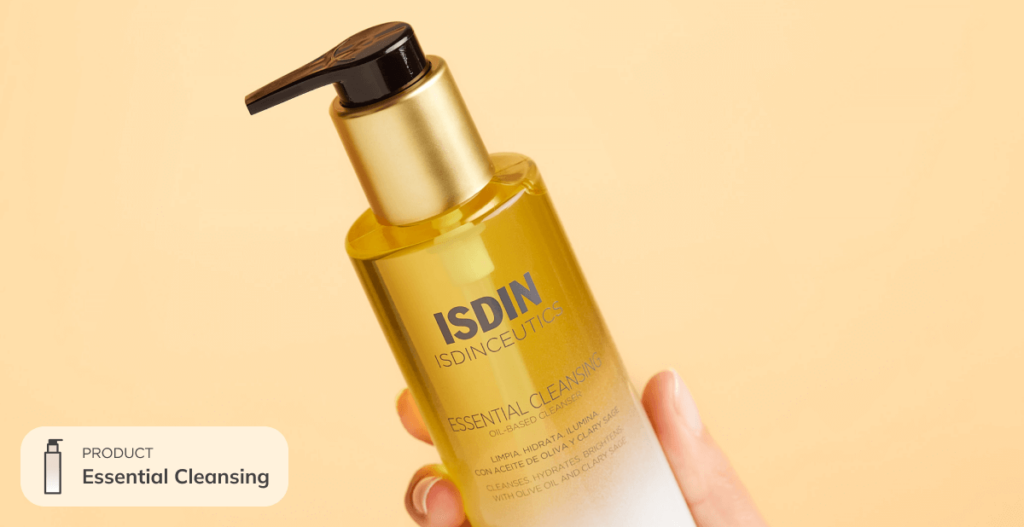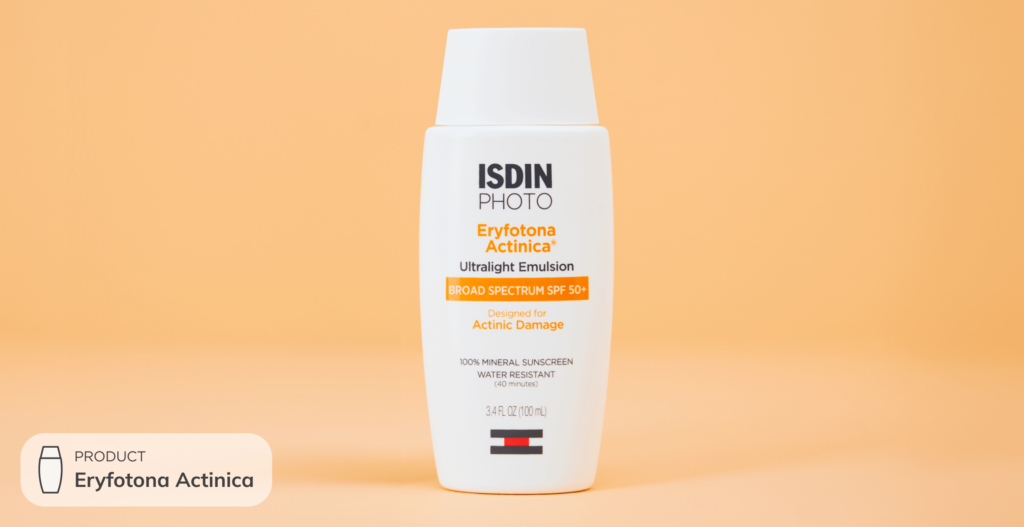Your skin is just as unique as you are — making it important to embrace a skincare journey tailored to your specific needs. But when it comes to dry skin, the path to helping it look and feel its best can be full of twists and turns.
The shortcut? A consistent routine designed to restore and retain moisture. Join us as we share essential tips and straightforward steps to help nourish dry skin.
Let’s get started.
skin“>skin“>What causes dry skin?
Dry skin lacks water, but it’s also running on a low supply of natural oils. And these natural oils (AKA sebum) help keep your skin-barrier/”>skin barrier functioning at its best. What makes the skin barrier so noteworthy? This brick-and-mortar-like structure is your skin’s first line of defense against the outside world. Its main job is to protect you from pathogens while balancing your skin’s moisture levels.
In normal skin, the barrier helps keep the bad stuff out (irritants, pollution) and the good stuff in (water, oils). But, in dry skin, the skin/”>layer of skin that your barrier calls home is permanently altered. This means that your skin cells lose some of their power to retain and replenish water.
skin-look-and-feel-like”>skin-look-and-feel-like”>What does dry skin look (and feel) like?
- You have refined, barely-visible pores
- It feels tight, especially after washing your face
- You’re used to a matte complexion (without shine)
Sometimes these signs appear all over or only in one specific place, such as the nose or cheeks. Either way, a targeted skincare routine can help relieve dryness and set you on the path to smooth, comfortable skin.
 skin look (and feel) like?” class=”wp-image-9096 lazyload” data-sizes=”auto” srcset=”https://www.isdin.com/us/blog/wp-content/uploads/2020/10/2023_DrySkin_IMG01-1024×527.png 1024w, https://www.isdin.com/us/blog/wp-content/uploads/2020/10/2023_DrySkin_IMG01-300×155.png 300w, https://www.isdin.com/us/blog/wp-content/uploads/2020/10/2023_DrySkin_IMG01-150×77.png 150w, https://www.isdin.com/us/blog/wp-content/uploads/2020/10/2023_DrySkin_IMG01-768×396.png 768w, https://www.isdin.com/us/blog/wp-content/uploads/2020/10/2023_DrySkin_IMG01-585×300.png 585w, https://www.isdin.com/us/blog/wp-content/uploads/2020/10/2023_DrySkin_IMG01-450×232.png 450w, https://www.isdin.com/us/blog/wp-content/uploads/2020/10/2023_DrySkin_IMG01-20×11.png 20w, https://www.isdin.com/us/blog/wp-content/uploads/2020/10/2023_DrySkin_IMG01-225×116.png 225w, https://www.isdin.com/us/blog/wp-content/uploads/2020/10/2023_DrySkin_IMG01-900×464.png 900w, https://www.isdin.com/us/blog/wp-content/uploads/2020/10/2023_DrySkin_IMG01-186×96.png 186w, https://www.isdin.com/us/blog/wp-content/uploads/2020/10/2023_DrySkin_IMG01.png 1200w” sizes=”(max-width: 1024px) 100vw, 1024px”/>
skin look (and feel) like?” class=”wp-image-9096 lazyload” data-sizes=”auto” srcset=”https://www.isdin.com/us/blog/wp-content/uploads/2020/10/2023_DrySkin_IMG01-1024×527.png 1024w, https://www.isdin.com/us/blog/wp-content/uploads/2020/10/2023_DrySkin_IMG01-300×155.png 300w, https://www.isdin.com/us/blog/wp-content/uploads/2020/10/2023_DrySkin_IMG01-150×77.png 150w, https://www.isdin.com/us/blog/wp-content/uploads/2020/10/2023_DrySkin_IMG01-768×396.png 768w, https://www.isdin.com/us/blog/wp-content/uploads/2020/10/2023_DrySkin_IMG01-585×300.png 585w, https://www.isdin.com/us/blog/wp-content/uploads/2020/10/2023_DrySkin_IMG01-450×232.png 450w, https://www.isdin.com/us/blog/wp-content/uploads/2020/10/2023_DrySkin_IMG01-20×11.png 20w, https://www.isdin.com/us/blog/wp-content/uploads/2020/10/2023_DrySkin_IMG01-225×116.png 225w, https://www.isdin.com/us/blog/wp-content/uploads/2020/10/2023_DrySkin_IMG01-900×464.png 900w, https://www.isdin.com/us/blog/wp-content/uploads/2020/10/2023_DrySkin_IMG01-186×96.png 186w, https://www.isdin.com/us/blog/wp-content/uploads/2020/10/2023_DrySkin_IMG01.png 1200w” sizes=”(max-width: 1024px) 100vw, 1024px”/>skin“>skin“>Your step-by-step routine for normal to dry skin
When building a skincare routine to combat dryness, the mantra is simple (and maybe a little obvious): hydrate, hydrate, hydrate! Reach for products that help replenish lost moisture while working to keep your skin hydrated throughout the day.
Step 1: Nourishing oil cleanser
If your skin is dry and irritated, choosing the wrong cleanser could exaggerate things. Harsh cleansers can strip the skin of its natural oils, further damaging the moisture barrier and contributing to dryness, flakiness, and in some cases, irritation.
Opt for a gentle cleanser that respects your skin’s moisture barrier. Wondering where to start? An face–care/isdinceutics-essential-cleansing-oil-8429420218758.html”>oil cleanser is your best bet for a deep clean that doesn’t strip the skin. Oil attracts oil, making it ideal for gently removing greasy residues, stubborn makeup, and sunscreen.
Most importantly, look for oil cleansers with the softness of an emulsion. This mild texture helps to keep dry skin comfortable while cleansing and afterwards. Our pick: face–care/isdinceutics-essential-cleansing-oil-8429420218758.html”>Essential Cleansing.
 skin” class=”wp-image-9097 lazyload” data-sizes=”auto” srcset=”https://www.isdin.com/us/blog/wp-content/uploads/2020/10/2023_DrySkin_IMG04-1024×527.png 1024w, https://www.isdin.com/us/blog/wp-content/uploads/2020/10/2023_DrySkin_IMG04-300×155.png 300w, https://www.isdin.com/us/blog/wp-content/uploads/2020/10/2023_DrySkin_IMG04-150×77.png 150w, https://www.isdin.com/us/blog/wp-content/uploads/2020/10/2023_DrySkin_IMG04-768×396.png 768w, https://www.isdin.com/us/blog/wp-content/uploads/2020/10/2023_DrySkin_IMG04-585×300.png 585w, https://www.isdin.com/us/blog/wp-content/uploads/2020/10/2023_DrySkin_IMG04-450×232.png 450w, https://www.isdin.com/us/blog/wp-content/uploads/2020/10/2023_DrySkin_IMG04-20×11.png 20w, https://www.isdin.com/us/blog/wp-content/uploads/2020/10/2023_DrySkin_IMG04-225×116.png 225w, https://www.isdin.com/us/blog/wp-content/uploads/2020/10/2023_DrySkin_IMG04-900×464.png 900w, https://www.isdin.com/us/blog/wp-content/uploads/2020/10/2023_DrySkin_IMG04-186×96.png 186w, https://www.isdin.com/us/blog/wp-content/uploads/2020/10/2023_DrySkin_IMG04.png 1200w” sizes=”(max-width: 1024px) 100vw, 1024px”/>
skin” class=”wp-image-9097 lazyload” data-sizes=”auto” srcset=”https://www.isdin.com/us/blog/wp-content/uploads/2020/10/2023_DrySkin_IMG04-1024×527.png 1024w, https://www.isdin.com/us/blog/wp-content/uploads/2020/10/2023_DrySkin_IMG04-300×155.png 300w, https://www.isdin.com/us/blog/wp-content/uploads/2020/10/2023_DrySkin_IMG04-150×77.png 150w, https://www.isdin.com/us/blog/wp-content/uploads/2020/10/2023_DrySkin_IMG04-768×396.png 768w, https://www.isdin.com/us/blog/wp-content/uploads/2020/10/2023_DrySkin_IMG04-585×300.png 585w, https://www.isdin.com/us/blog/wp-content/uploads/2020/10/2023_DrySkin_IMG04-450×232.png 450w, https://www.isdin.com/us/blog/wp-content/uploads/2020/10/2023_DrySkin_IMG04-20×11.png 20w, https://www.isdin.com/us/blog/wp-content/uploads/2020/10/2023_DrySkin_IMG04-225×116.png 225w, https://www.isdin.com/us/blog/wp-content/uploads/2020/10/2023_DrySkin_IMG04-900×464.png 900w, https://www.isdin.com/us/blog/wp-content/uploads/2020/10/2023_DrySkin_IMG04-186×96.png 186w, https://www.isdin.com/us/blog/wp-content/uploads/2020/10/2023_DrySkin_IMG04.png 1200w” sizes=”(max-width: 1024px) 100vw, 1024px”/>Step 2: Hydrating eye cream
Your everyday environment can affect your skin more than you might realize. These skin-affecting factors are called the exposome and include things like UV radiation, temperature, stress, and pollution.
Unfortunately, all of these daily factors can mess with your skin barrier. One of the thinnest areas of skin on your entire body, the delicate under-eye area, is particularly sensitive to these stressors — making it even more important to moisturize and protect it. Look for an eye contour formula designed to deliver fast-acting yet lasting hydration. Our pick: Hyaluronic Eyes.

Step 3: Hydrating serum
Both morning and evening call for a hydrating serum. By helping boost natural moisture levels in the skin, some formulas can also help to calm and soothe, reducing the feeling of dryness associated with dehydration. Look for serums featuring humectants such as hyaluronic acid and glycerin.
How do humectants work? These hydration heroes help draw in water molecules and bind to them, retaining moisture in the skin. Hyaluronic acid also offers a plumping effect, counteracting loss of elasticity — making hyaluronic acid serums a popular choice. Our pick: face–care/hyaluronic-concentrate-8429420200678.html”>Hyaluronic Concentrate.

Step 4: Targeted moisturizer
Now it’s time to seal in moisture with a comforting formula. This step helps to keep in all the hydrating goodness of a serum, plus minimize moisture loss as the day goes by. Where to start? A skin-8429420222779.html”>lightweight yet hard-working moisturizer can help to deeply hydrate, protect your natural moisture barrier, and support well-aging. Our pick: skin/4052″>Hyaluronic Moisture Normal to Dry skin
 skin” class=”wp-image-9217 lazyload” data-sizes=”auto” srcset=”https://www.isdin.com/us/blog/wp-content/uploads/2023/11/2024_DrySkin_IMG02-1024×527.png 1024w, https://www.isdin.com/us/blog/wp-content/uploads/2023/11/2024_DrySkin_IMG02-300×155.png 300w, https://www.isdin.com/us/blog/wp-content/uploads/2023/11/2024_DrySkin_IMG02-150×77.png 150w, https://www.isdin.com/us/blog/wp-content/uploads/2023/11/2024_DrySkin_IMG02-768×396.png 768w, https://www.isdin.com/us/blog/wp-content/uploads/2023/11/2024_DrySkin_IMG02-1536×791.png 1536w, https://www.isdin.com/us/blog/wp-content/uploads/2023/11/2024_DrySkin_IMG02-2048×1055.png 2048w, https://www.isdin.com/us/blog/wp-content/uploads/2023/11/2024_DrySkin_IMG02-585×300.png 585w, https://www.isdin.com/us/blog/wp-content/uploads/2023/11/2024_DrySkin_IMG02-450×232.png 450w, https://www.isdin.com/us/blog/wp-content/uploads/2023/11/2024_DrySkin_IMG02-20×11.png 20w, https://www.isdin.com/us/blog/wp-content/uploads/2023/11/2024_DrySkin_IMG02-225×116.png 225w, https://www.isdin.com/us/blog/wp-content/uploads/2023/11/2024_DrySkin_IMG02-900×464.png 900w, https://www.isdin.com/us/blog/wp-content/uploads/2023/11/2024_DrySkin_IMG02-1350×695.png 1350w, https://www.isdin.com/us/blog/wp-content/uploads/2023/11/2024_DrySkin_IMG02-186×96.png 186w” sizes=”auto, (max-width: 1024px) 100vw, 1024px”/>
skin” class=”wp-image-9217 lazyload” data-sizes=”auto” srcset=”https://www.isdin.com/us/blog/wp-content/uploads/2023/11/2024_DrySkin_IMG02-1024×527.png 1024w, https://www.isdin.com/us/blog/wp-content/uploads/2023/11/2024_DrySkin_IMG02-300×155.png 300w, https://www.isdin.com/us/blog/wp-content/uploads/2023/11/2024_DrySkin_IMG02-150×77.png 150w, https://www.isdin.com/us/blog/wp-content/uploads/2023/11/2024_DrySkin_IMG02-768×396.png 768w, https://www.isdin.com/us/blog/wp-content/uploads/2023/11/2024_DrySkin_IMG02-1536×791.png 1536w, https://www.isdin.com/us/blog/wp-content/uploads/2023/11/2024_DrySkin_IMG02-2048×1055.png 2048w, https://www.isdin.com/us/blog/wp-content/uploads/2023/11/2024_DrySkin_IMG02-585×300.png 585w, https://www.isdin.com/us/blog/wp-content/uploads/2023/11/2024_DrySkin_IMG02-450×232.png 450w, https://www.isdin.com/us/blog/wp-content/uploads/2023/11/2024_DrySkin_IMG02-20×11.png 20w, https://www.isdin.com/us/blog/wp-content/uploads/2023/11/2024_DrySkin_IMG02-225×116.png 225w, https://www.isdin.com/us/blog/wp-content/uploads/2023/11/2024_DrySkin_IMG02-900×464.png 900w, https://www.isdin.com/us/blog/wp-content/uploads/2023/11/2024_DrySkin_IMG02-1350×695.png 1350w, https://www.isdin.com/us/blog/wp-content/uploads/2023/11/2024_DrySkin_IMG02-186×96.png 186w” sizes=”auto, (max-width: 1024px) 100vw, 1024px”/>Step 5: Broad spectrum sunscreen
No matter your skin type, sunscreen is a must. Daily use helps protect it from damaging UV rays and minimizes further dehydration or dryness due to the sun’s harsh effects.
Mineral formulas are a good choice for normal to dry skin, as they are generally suitable for a wide range of skin types. Choose a mineral formula with moisturizing ingredients such as vitamin E to help keep your skin protected and boost hydration.
 skin” class=”wp-image-9107 lazyload” data-sizes=”auto” srcset=”https://www.isdin.com/us/blog/wp-content/uploads/2020/10/2023_DrySkin_IMG10-1024×527.png 1024w, https://www.isdin.com/us/blog/wp-content/uploads/2020/10/2023_DrySkin_IMG10-300×155.png 300w, https://www.isdin.com/us/blog/wp-content/uploads/2020/10/2023_DrySkin_IMG10-150×77.png 150w, https://www.isdin.com/us/blog/wp-content/uploads/2020/10/2023_DrySkin_IMG10-768×396.png 768w, https://www.isdin.com/us/blog/wp-content/uploads/2020/10/2023_DrySkin_IMG10-1536×791.png 1536w, https://www.isdin.com/us/blog/wp-content/uploads/2020/10/2023_DrySkin_IMG10-2048×1055.png 2048w, https://www.isdin.com/us/blog/wp-content/uploads/2020/10/2023_DrySkin_IMG10-585×300.png 585w, https://www.isdin.com/us/blog/wp-content/uploads/2020/10/2023_DrySkin_IMG10-450×232.png 450w, https://www.isdin.com/us/blog/wp-content/uploads/2020/10/2023_DrySkin_IMG10-20×11.png 20w, https://www.isdin.com/us/blog/wp-content/uploads/2020/10/2023_DrySkin_IMG10-225×116.png 225w, https://www.isdin.com/us/blog/wp-content/uploads/2020/10/2023_DrySkin_IMG10-900×464.png 900w, https://www.isdin.com/us/blog/wp-content/uploads/2020/10/2023_DrySkin_IMG10-1350×695.png 1350w, https://www.isdin.com/us/blog/wp-content/uploads/2020/10/2023_DrySkin_IMG10-186×96.png 186w” sizes=”auto, (max-width: 1024px) 100vw, 1024px”/>
skin” class=”wp-image-9107 lazyload” data-sizes=”auto” srcset=”https://www.isdin.com/us/blog/wp-content/uploads/2020/10/2023_DrySkin_IMG10-1024×527.png 1024w, https://www.isdin.com/us/blog/wp-content/uploads/2020/10/2023_DrySkin_IMG10-300×155.png 300w, https://www.isdin.com/us/blog/wp-content/uploads/2020/10/2023_DrySkin_IMG10-150×77.png 150w, https://www.isdin.com/us/blog/wp-content/uploads/2020/10/2023_DrySkin_IMG10-768×396.png 768w, https://www.isdin.com/us/blog/wp-content/uploads/2020/10/2023_DrySkin_IMG10-1536×791.png 1536w, https://www.isdin.com/us/blog/wp-content/uploads/2020/10/2023_DrySkin_IMG10-2048×1055.png 2048w, https://www.isdin.com/us/blog/wp-content/uploads/2020/10/2023_DrySkin_IMG10-585×300.png 585w, https://www.isdin.com/us/blog/wp-content/uploads/2020/10/2023_DrySkin_IMG10-450×232.png 450w, https://www.isdin.com/us/blog/wp-content/uploads/2020/10/2023_DrySkin_IMG10-20×11.png 20w, https://www.isdin.com/us/blog/wp-content/uploads/2020/10/2023_DrySkin_IMG10-225×116.png 225w, https://www.isdin.com/us/blog/wp-content/uploads/2020/10/2023_DrySkin_IMG10-900×464.png 900w, https://www.isdin.com/us/blog/wp-content/uploads/2020/10/2023_DrySkin_IMG10-1350×695.png 1350w, https://www.isdin.com/us/blog/wp-content/uploads/2020/10/2023_DrySkin_IMG10-186×96.png 186w” sizes=”auto, (max-width: 1024px) 100vw, 1024px”/>You’re not the only one wondering: Can I exfoliate if I have dry skin? It’s a common myth that you shouldn’t. But following a few tips, exfoliation can be an essential ally for dry skin.
The truth is that some manual exfoliants (think scrubs and brushes) can irritate the skin and lead to more dryness and redness. With dry skin, chemical exfoliants like AHAs (alpha-hydroxy acids) are typically a good choice, especially in gentle formulas.
Ever heard of glycolic acid? It’s an AHA exfoliant with water-attracting properties, meaning in lower concentrations it’s effective while still being kind to dry skin. Try getting started with glycolic acid one or two nights a week and then build up from there if needed. Just remember to wear sun protection without fail, as exfoliation can make the skin more sensitive to the sun. Our PM pick: face–care/glicoisdin-8-soft-8429420175341.html”>Glicoisdin® 8 Soft
 skin” class=”wp-image-9221 lazyload” data-sizes=”auto” srcset=”https://www.isdin.com/us/blog/wp-content/uploads/2024/02/2024_DrySkin_IMG03-1024×527.png 1024w, https://www.isdin.com/us/blog/wp-content/uploads/2024/02/2024_DrySkin_IMG03-300×155.png 300w, https://www.isdin.com/us/blog/wp-content/uploads/2024/02/2024_DrySkin_IMG03-150×77.png 150w, https://www.isdin.com/us/blog/wp-content/uploads/2024/02/2024_DrySkin_IMG03-768×396.png 768w, https://www.isdin.com/us/blog/wp-content/uploads/2024/02/2024_DrySkin_IMG03-1536×791.png 1536w, https://www.isdin.com/us/blog/wp-content/uploads/2024/02/2024_DrySkin_IMG03-2048×1055.png 2048w, https://www.isdin.com/us/blog/wp-content/uploads/2024/02/2024_DrySkin_IMG03-585×300.png 585w, https://www.isdin.com/us/blog/wp-content/uploads/2024/02/2024_DrySkin_IMG03-450×232.png 450w, https://www.isdin.com/us/blog/wp-content/uploads/2024/02/2024_DrySkin_IMG03-20×11.png 20w, https://www.isdin.com/us/blog/wp-content/uploads/2024/02/2024_DrySkin_IMG03-225×116.png 225w, https://www.isdin.com/us/blog/wp-content/uploads/2024/02/2024_DrySkin_IMG03-900×464.png 900w, https://www.isdin.com/us/blog/wp-content/uploads/2024/02/2024_DrySkin_IMG03-1350×695.png 1350w, https://www.isdin.com/us/blog/wp-content/uploads/2024/02/2024_DrySkin_IMG03-186×96.png 186w” sizes=”auto, (max-width: 1024px) 100vw, 1024px”/>
skin” class=”wp-image-9221 lazyload” data-sizes=”auto” srcset=”https://www.isdin.com/us/blog/wp-content/uploads/2024/02/2024_DrySkin_IMG03-1024×527.png 1024w, https://www.isdin.com/us/blog/wp-content/uploads/2024/02/2024_DrySkin_IMG03-300×155.png 300w, https://www.isdin.com/us/blog/wp-content/uploads/2024/02/2024_DrySkin_IMG03-150×77.png 150w, https://www.isdin.com/us/blog/wp-content/uploads/2024/02/2024_DrySkin_IMG03-768×396.png 768w, https://www.isdin.com/us/blog/wp-content/uploads/2024/02/2024_DrySkin_IMG03-1536×791.png 1536w, https://www.isdin.com/us/blog/wp-content/uploads/2024/02/2024_DrySkin_IMG03-2048×1055.png 2048w, https://www.isdin.com/us/blog/wp-content/uploads/2024/02/2024_DrySkin_IMG03-585×300.png 585w, https://www.isdin.com/us/blog/wp-content/uploads/2024/02/2024_DrySkin_IMG03-450×232.png 450w, https://www.isdin.com/us/blog/wp-content/uploads/2024/02/2024_DrySkin_IMG03-20×11.png 20w, https://www.isdin.com/us/blog/wp-content/uploads/2024/02/2024_DrySkin_IMG03-225×116.png 225w, https://www.isdin.com/us/blog/wp-content/uploads/2024/02/2024_DrySkin_IMG03-900×464.png 900w, https://www.isdin.com/us/blog/wp-content/uploads/2024/02/2024_DrySkin_IMG03-1350×695.png 1350w, https://www.isdin.com/us/blog/wp-content/uploads/2024/02/2024_DrySkin_IMG03-186×96.png 186w” sizes=”auto, (max-width: 1024px) 100vw, 1024px”/>Sources and references:
Hashizume H. skin aging and dry skin. J Dermatol. 2004 Aug;31(8):603-9. doi: 10.1111/j.1346-8138.2004.tb00565.x. PMID: 15492432.
Van Smeden, J., Janssens, M., Gooris, G. S., & Bouwstra, J. A. (2014). The important role of stratum corneum lipids for the cutaneous barrier function. Biochimica Et Biophysica Acta (BBA) – Molecular and Cell Biology of Lipids, 1841(3), 295–313. https://doi.org/10.1016/j.bbalip.2013.11.006
Tončić, R. J., Kežić, S., Hadžavdić, S. L., & Marinović, B. (2018). skin barrier and dry skin in the mature patient. Clinics in Dermatology, 36(2), 109–115. https://doi.org/10.1016/j.clindermatol.2017.10.002
Editorial Team
Our namesake embodies the spirit of embracing life and all its wonder. As wellness journalists, we explore topics that invigorate the senses and keep curiosity alive. We believe that glowing skin is the result of a healthy body and mind. Weaving beauty with science, we aim to inspire you to live young at every age.
skin/”>Source link



